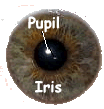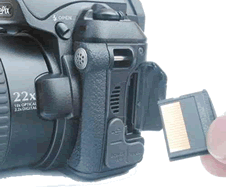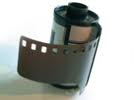|
For the pin hole camera (one that doesn't need a lens!) see here.
A Single Lens Reflex Camera
 To record an image on film or on a digital camera's memory card we need to have a real image. We therefore need a convex lens in our camera and to position the object further away than the focal length of the lens. To record an image on film or on a digital camera's memory card we need to have a real image. We therefore need a convex lens in our camera and to position the object further away than the focal length of the lens.
The further away the object is the smaller the image will be on the film or array of sensors. The above diagram is a simple camera (the type you would get in an examination question at GCSE). Today's cameras are much more complex. You have to understand the basic lens function and the similarity between the camera and the human eye.
The viewfinder in SLR Cameras - Single Lens Reflex Cameras
In an SLR camera, you see the real image that the  film or digital sensor will record through a viewfinder. Have you ever wondered how this is possible? film or digital sensor will record through a viewfinder. Have you ever wondered how this is possible?
The camera has a slanted mirror positioned between the shutter and the lens, with a piece of translucent glass and a prism positioned above it. This arrangement works like a periscope and the image is reflected off the lower mirror on to the translucent glass, which works like a projection screen. The prism's job is to turn the image onto the screen, so it appears right way up again, and redirect it on to the viewfinder window allowing you to see what you are photographing.

When you click the shutter button, the camera quickly moves the mirror out of the way, so the image is directed at the exposed film or digital sensor array. The mirror is connected to the shutter timer system, so it stays open as long as the shutter is open. This is why the viewfinder is suddenly blacked out when you take a picture.
The camera and the human eye
The camera is similar to our eyes. It has a lot of functions that correspond to how our eyes work.
Human Eye |
Camera |
|
Eyelid |
Shutter |
Is an opaque covering that is able to prevent light from entering the viewing system |
Iris |
Iris |
An adjustable circular aperture. The eye automatically adhusts the hole in the centre of this to allow the correct amount of light through to the system. In bright light it closes to give a pinpoint hole (pupil) in dim light it allows the pupil to widen to allow in more light energy. In a camera this can be done manualy (or in some cameras automatic electronic response is used) |
Pupil |
Aperture |
Hole in the iris that lets light enter the system. |
Retina |
Film or array of photosite sensors |
The back of the eye is covered with light sensitive cells - see below for more detail - these allow us to record the image by changing the light energy to electrical energy so that a message can be sent to the brain. A photographic film records the image using light sensitive chemicals and a digital camera's array of photosites records the image using light sensitive electronic components that change the light energy into electrical energy in a very similar way to our eye system. |
cone cells |
filtered photosite sensors |
see 'Film' below |
rod cells |
photosite sensors |
see 'Flim' below |
cornea |
lens |
The cornea is the major refractor in the human eye. It refracts the light on entry to the image processing system |
lens |
additional lenses and/or system to move the lens towards or away from the recording medium |
The lens of the human eye allows accomodation of the imaging system - making fine adjustment so that a sharp image is obtained on the retina. Muscles squeeze the eye lens to change the degree of curvature. Making it mmore curved increases its power.
In a camera this effect is obtained by moving the lens to the optimum position by extending the lens housing or by selecting a lens of different power from several incorporated within the camera. |
optic nerve |
connections to the memory card |
|
brain's visual cortex (where visual information is processed) and visual memory storage area

|
memory card of a digital computer

|
Visual memories can remain with us a long time or be lost in a few seconds. Camera 'memories' can be kept for a very long time if they are put onto a photograph or stored digitally. |
Photographic film cameras capture their images on acetate coated with a light sensitive chemical . When light energy falls on the chemical a reaction occurs and the chemical changes. The film is then 'fixed' when it is processed by another chemical process making 'negatives' of the image.
Just as the chemical coating on the film absorbs the light that falls on it, the light sensitive cells (rods and cones) on the retina absorb light photons within the eye. |
 |
Digital cameras capture their images by using a silicon semiconductor device called a digital sensor. This sensor is made up of an array of photosensitive diodes called 'photosites' that capture light energy and convert it to electrical energy.
The image sensor employed by most digital cameras is a charge coupled device (CCD). Some cameras use complementary metal oxide semiconductor (CMOS) technology instead. But both CCD and CMOS image sensors convert light into electrrical energy.
Once the sensor converts the light into electrons, it reads the value (accumulated charge) of each cell in the image. This is where a difference between the two main sensor types becomes apparent.
 A CCD transports the charge across the chip and reads it at one corner of the array. An analog-to-digital converter (ADC) then turns each pixel's value into a digital value by measuring the amount of charge at each photosite and converting that measurement to binary form. A CCD transports the charge across the chip and reads it at one corner of the array. An analog-to-digital converter (ADC) then turns each pixel's value into a digital value by measuring the amount of charge at each photosite and converting that measurement to binary form.
 CMOS devices use several transistors at each pixel to amplify and move the charge using more traditional wires. CMOS devices use several transistors at each pixel to amplify and move the charge using more traditional wires.
|
This is like the way light sensitive cells on the retina absorb light photons within the eye. |
 Unfortunately, each photosite is colourblind. It only detects the intensity of the light that strikes its surface. In order to get a full colour image, most sensors use filtering to look at the light in its three primary colours - red, green and blue. Neigbouring photosites monitor the same point on the object and are filtered to collect only light in one frequency band range. This is done to mimic the behaviour of the human eye. Unfortunately, each photosite is colourblind. It only detects the intensity of the light that strikes its surface. In order to get a full colour image, most sensors use filtering to look at the light in its three primary colours - red, green and blue. Neigbouring photosites monitor the same point on the object and are filtered to collect only light in one frequency band range. This is done to mimic the behaviour of the human eye.
|
Within the human eye there are special light sensitive cells called cones that are only sensitive to one of three frequency ranges of the visible light spectrum. The rods are cells that only work like unfiltered photosites. |
The size of the voltage buildup on each photosite is converted into digital data as a picture element or ‘pixel’. These pixels are then relayed in consecutive order and stored as an image on the camera’s memory as a file. |
This is similar to the way that the optic nerve transmits visual information to the brain. |
These files can then be viewed on the camera in the LCD screen, or uploaded to a computer where they can also be viewed or manipulated with imaging software. |
This corresponds to the way we observe images without eyes... or remember what we have seen in our mind's eye. |
See 'The Camera' in How Stuff Works and 'The Digital Camera' - that will give you more detail.
|




 The Camera
The Camera


 To record an image on film or on a digital camera's memory card we need to have a real image. We therefore need a convex lens in our camera and to position the object further away than the focal length of the lens.
To record an image on film or on a digital camera's memory card we need to have a real image. We therefore need a convex lens in our camera and to position the object further away than the focal length of the lens.







 A CCD transports the charge across the chip and reads it at one corner of the array. An analog-to-digital converter (ADC) then turns each pixel's value into a digital value by measuring the amount of charge at each photosite and converting that measurement to binary form.
A CCD transports the charge across the chip and reads it at one corner of the array. An analog-to-digital converter (ADC) then turns each pixel's value into a digital value by measuring the amount of charge at each photosite and converting that measurement to binary form.  Unfortunately, each photosite is colourblind. It only detects the intensity of the light that strikes its surface. In order to get a full colour image, most sensors use
Unfortunately, each photosite is colourblind. It only detects the intensity of the light that strikes its surface. In order to get a full colour image, most sensors use 
